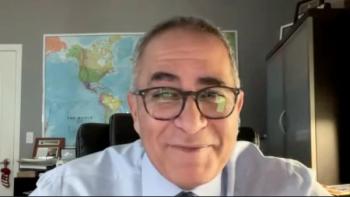
Daratumumab + European Standard Yields Clinical Benefit in Transplant Eligible, Newly Diagnosed Myeloma
New data from the CASSIOPEIA trial evaluated the use of daratumumab in addition to bortezomib/thalidomide/dexamethasone after ASCT in multiple myeloma.
CHICAGO-New data from the CASSIOPEIA trial supports the use of daratumumab in addition to bortezomib/thalidomide/dexamethasone (VTd) prior to and as consolidation therapy after autologous stem cell transplantation in patients with newly diagnosed multiple myeloma.
Results from the primary and final analysis (
“Daratumumab should be considered a valid treatment option for newly diagnosed multiple myeloma patients who are eligible for autologous stem cell transplant,” said Philippe Moreau, MD, of University Hospital Hotel-Dieu, Nantes, France.
In this Part 1 of the CASSIOPEIA trial, 1,085 patients with transplant eligible, newly diagnosed multiple myeloma were randomly assigned to VTd with or without daratumumab as induction and consolidation therapy. Melphalan was given as pre-transplant therapy. The primary endpoint was post-consolidation stringent complete response as assessed at Day 100 post-transplant.
Overall response rate was similar between the two arms, at 93% for the daratumumab arm and 90% for the VTd arm. However, there was a significant improvement in complete response associated with daratumumab (39% vs 26%; P < .0001). The addition of daratumumab also improved the depth of response with a significant improvement in stringent complete response for patients assigned to the daratumumab arm compared with standard-of-care VTd (28.9% vs 20.3%; P = .0010).
According to Moreau, combined treatment with daratumumab was superior to VTd alone across all subgroups except patients with a high-risk cytogenetic profile and stage III ISS disease stage.
When looking at efficacy by minimum residual disease (MRD) negativity, daratumumab plus VTd had a MRD negativity rate of 64% compared with 44% for VTd alone (P < .0001). Superiority of the daratumumab regimen remained across all subgroups, including those with high-risk cytogenetics and ISS stage II disease.
Progression-free survival from first randomization showed an 18-month progression-free survival of 93% for the daratumumab arm compared with 85% for the VTd arm, a 53% reduction in the risk for progression or death (hazard ratio, 0.47; 95% CI, 0.33–0.67; P < .0001). Median overall survival has not yet been reached in either arm.
The study discussant, Faith Davies, MD, of Perlmutter Cancer Center at NYU Langone, said that the results clearly demonstrate that these drugs, more commonly used as standard of care in Europe than in the United States, are effective in newly diagnosed patients.
“How does this apply to the United States where VRd [Velcade, Revlimid, dexamethasone] is the standard?” Davies asked. “We might say that the efficacy will be better with VRd because we know that Revlimid is better at inducing some of the immunomodulatory effects and has synergy when given with daratumumab. We would hope that side effects may also be better because we are moving away from thalidomide, so neuropathy would be improved.”
Newsletter
Stay up to date on recent advances in the multidisciplinary approach to cancer.
















































































